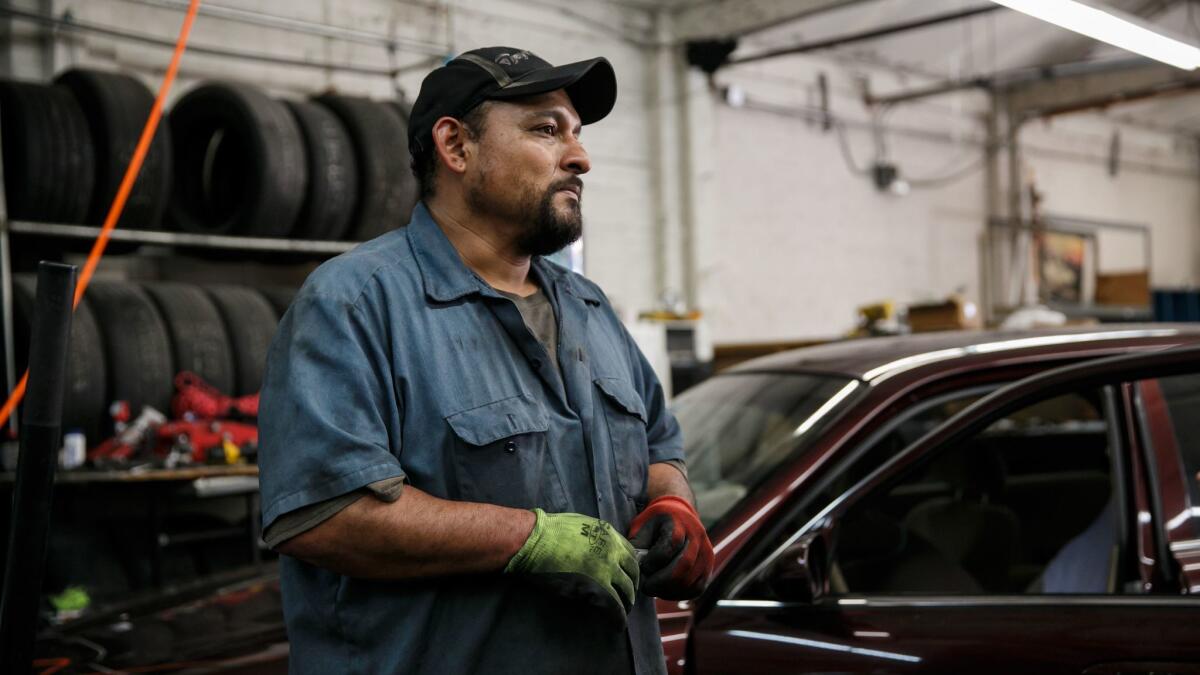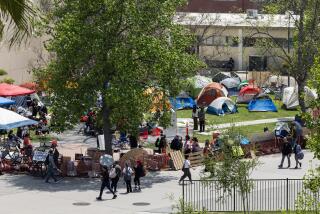L.A., Orange counties are home to 1 million immigrants who are in the country illegally, analysis shows
The chatter of Spanish serves as the backdrop of Pico-Union, where the aroma of pastries from the panaderia merge with the synthetic smells of an auto repair garage. A predominantly Latino neighborhood, it has for decades been a first stop for immigrants — both legal and illegal — coming from various corners of Latin America.
Over the years, this community has faced challenges, including from politicians threatening crackdowns on illegal immigration. But to many in this densely populated area near MacArthur Park, the presidency of Donald Trump poses a threat of an altogether different scale. Trump has vowed mass deportations of those here illegally, which if carried out, could fundamentally alter the rhythms of life in Pico-Union and numerous other immigrant enclaves around Southern California and beyond.
The potential threat of emptied homes and shuttered businesses has residents envisioning the worst.
“Una desolación. Imagínate no más,” worried Graciela Sandoval, 79, who has lived in Pico-Union for five decades. A desolation. Just imagine it.
“It’ll be a ghost town here,” added Manuel Blanco, 42, a lifelong Pico-Union resident who runs an auto repair shop in the area. “It’s not even going to be worth being in business.”

An analysis released Thursday by the Pew Research Center underscores just how much immigrants here illegally have been embedded into the culture and economy of Los Angeles. Woven, often seamlessly, into dozens of cities’ infrastructures, they have become a workforce and community that makes up much of the fabric of Southern California.
Nearly 10% of the nation’s 11.1 million immigrants who are in the country illegally reside in Los Angeles and Orange counties, according to the research center. The region is home to 1 million such immigrants, second only to the greater New York area, which has 1.2 million. Third on the list was Houston with 575,000. The city of Los Angeles alone has an estimated 375,000.
Up to 8 million people in the country illegally could be considered priorities for deportation, according to calculations by The Times based on interviews with experts who studied internal documents related to Trump’s directive. Trump has said that his order allows immigration officials to detain nearly anyone who has crossed the border illegally.
The Pew analysis, using augmented 2014 data collected by the American Community Survey, which is conducted by the U.S. Census Bureau, focused on the 20 major metropolitan areas with the highest numbers of immigrants here illegally. It showed that the population tends to live among legal immigrants and is highly concentrated.
In 2014, 61% of immigrants here illegally lived in those 20 metropolitan areas, whereas only 36% of the total U.S. population lived in the same regions. All but one of the areas remained in the top 20 over the previous decade.
Five of those — including Riverside, San Francisco, San Diego and San Jose — were in California, a state at the forefront of the sanctuary movement, where leaders have insisted cities will continue to offer refuge to immigrants in the face of Trump’s threat to cut their funds.
Although Los Angeles has not explicitly declared itself a sanctuary city, it has taken measures to protect those here illegally. Early this month, City Council members pushed forward a plan to draft a law that would decriminalize street vending. Many, if not most, who peddle items like bacon-wrapped hot dogs, fruit and ice cream are in the country illegally, and city leaders hope to keep them from being charged for selling goods or food on the sidewalk — which would make them more vulnerable to deportation.
If the unauthorized population were to leave areas where they contribute to the local economy, cities could find themselves in trouble.
“They would face not just a loss of population or loss of labor … but also loss of buying power,” said Louis DeSipio, a professor of political science at UC Irvine who specializes in immigration from Latin America.
Immigrants who are here illegally often contribute to the economy even in neighborhoods where they don’t live, as service workers in restaurants or in the homes of the more well-heeled.
In Santa Ana, businesses catering to immigrants kept the downtown financially viable after white residents left decades earlier. The county seat of Orange County, Santa Ana boasts a downtown with gourmet restaurants and hipster shops, but its vibrancy is fueled by the Mexican immigrant community — a good portion of which lacks legal status.
On Sundays, vehicles cruise 4th Street blaring Mexican ranchera music while families amble about bridal and hair salons, snack carts, jewelry shops and check-cashing stores that wire money to Latin America.
Claudia Arellanes, secretary of the Santa Ana Business Council and owner of a furniture store, said the area is reliant on its immigrant clientele.
“Many people don’t understand this,” she said. “It would be devastating. The downtown area would fail.”
Businesses that don’t specifically cater to new immigrants, such as mainstream malls, movie theaters and restaurants, also reap the benefits from a large unauthorized population that quickly acculturates to its surroundings, DeSipio said.
In Maywood, a 1.2-square-mile municipality that declared itself a sanctuary city more than a decade ago, the effects of Trump’s directive have residents envisioning a collapsed community. According to the U.S. Census Bureau, the city has a population of 28,000, but city officials say that number doubles when immigrants in the country illegally are included.
Residents can point out neighbor after neighbor who don’t have documents. Most have relatives in the same situation. Friends, too.
“You would have empty homes and empty apartments,” Mayor Pro Tem Eduardo De La Riva said of potential mass deportations. “People would be afraid to come outside.”
To read this article in Spanish, click here.
Times staff writer Ruben Vives contributed to this report.
ALSO:
Californians are keeping their lawmakers’ phones ringing: ‘They really hate Donald Trump’
Congress takes aim at California law mandating retirement savings plans for low-income workers
L.A.’s mayor wants to lower the city’s temperature. These scientists are figuring out how to do it
UPDATES:
3:50 p.m: This article was updated with details from Santa Ana and Maywood.
2:35 p.m.: This article was updated with an assessment of the effect of mass deportations on the Pico-Union neighborhood of Los Angeles.
12:50 p.m.: This article was updated with information about Maywood and comments from a Maywood city councilman.
This article was originally posted at 9 a.m.
More to Read
Start your day right
Sign up for Essential California for news, features and recommendations from the L.A. Times and beyond in your inbox six days a week.
You may occasionally receive promotional content from the Los Angeles Times.









